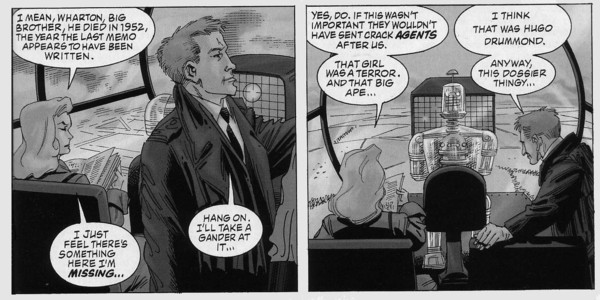I could go on about the political subtexts of League in general and Black Dossier in particular, but at this point I reckon you're either bored senseless or tempted to get your hands on the books yourselves, in which case you can make your own minds up.
It's probably worth pointing out, though, that while Black Dossier stands on its own merits, it is part of a series, serving as a bridge between League Volume II and Century, the coming three-part Volume III of League.
Thematically Moore has explained that the three parts of Century -- set in 1910, 1968, and 2008 -- will comment, among other things, on what Moore sees as the decline of the popular imagination. You can read elsewhere what Moore has revealed about the plot, but I think after this deranged week I'm in a mood for a little speculation. After all, adverts on the telly have demonstrated how spectacularly wrong I was in my suspicions about the Doctor Who Christmas episode, so I may as well embarrass myself yet again. I'll be shutting up about the Dossier after this post, anyway.
It's probably worth pointing out, though, that while Black Dossier stands on its own merits, it is part of a series, serving as a bridge between League Volume II and Century, the coming three-part Volume III of League.
Thematically Moore has explained that the three parts of Century -- set in 1910, 1968, and 2008 -- will comment, among other things, on what Moore sees as the decline of the popular imagination. You can read elsewhere what Moore has revealed about the plot, but I think after this deranged week I'm in a mood for a little speculation. After all, adverts on the telly have demonstrated how spectacularly wrong I was in my suspicions about the Doctor Who Christmas episode, so I may as well embarrass myself yet again. I'll be shutting up about the Dossier after this post, anyway.
 I realise that this is the historian in me coming out, but I can't help but notice when there are discrepancies going on with dates. Ropey chronology is something I have a nose for, and not just in historical matters -- NMRBoy could tell you how I ran riot last December, tearing to shreds an astoundingly malicious piece of fiction marked not merely by a host of demonstrable falsehoods but by the most absurdly inconsistent chronology.
I realise that this is the historian in me coming out, but I can't help but notice when there are discrepancies going on with dates. Ropey chronology is something I have a nose for, and not just in historical matters -- NMRBoy could tell you how I ran riot last December, tearing to shreds an astoundingly malicious piece of fiction marked not merely by a host of demonstrable falsehoods but by the most absurdly inconsistent chronology.Anyway, most of the documents within the Dossier come with notes attached or scrawled on them, all bar the last couple of notes being from Gerry O'Brien to General Sir Harold Wharton, Moore's 'Big Brother'. Wharton died, we're told on two occasions, in 1952.
But here's the thing: two of the memos from O'Brien to Wharton are on yellow post-it notes, attached to the front and back covers of the 'Life of Orlando' strip. The strip ran from 22 August 1953 to 17 October 1953. The dates of each issue are clearly marked on every single page.
Was O'Brien writing notes to a dead man? Was Wharton really dead?
I know, it could just be a mistake. But considering how carefully and precisely Moore has set up this world, I very much doubt it, especially when you consider Mina's observations above. She's right, surely. Why would M have sent such skilled agents after Mina and Allan unless he was really afraid of what they'd discover in the Dossier? And yet what was there of significance in the Dossier that they didn't already know -- with the possible exception of a reference to M having colluded with O'Brien in plotting Wharton's demise, a demise that I'm now inclined to suspect was staged?
I know, I know. Sometimes a cigar is just a cigar. I'm afraid that paranoid conspiracy theories are meat and drink to me at the moment. As NMRBoy asked the other day, does the plot ever do anything other than thicken?

2 comments:
post-it notes were first marketed in 1977.
n.
Mmmm. Having watched 'Romy and Michelle' a couple of years back, I'd a feeling that was the case.
Mind, it's not necressarily so in all parallels.
It may not be a post-it note, to be fair. It's yellow and stuck on the page, but it's a neat square by any means. There may be glue involved.
Post a Comment